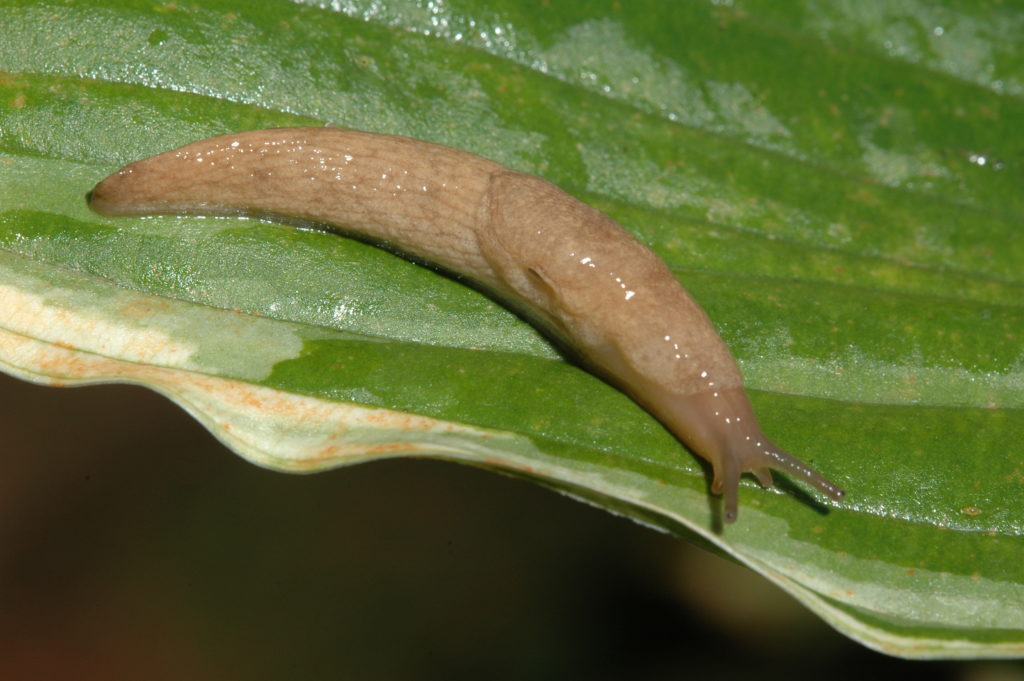What to do about garden slugs

Emerging at night to feast on a wide variety of plants, slugs are a slimy pest that can do a lot of damage to a garden. Vegetables, ornamentals, flowers — nothing is safe from slugs, which chew on leaves and stems alike. In addition, they leave behind trails of slime, which can be a task to remove from crops.
“Slug slime, once it dries, is pretty hard to get off,” said Jim Dill, pest management specialist at the University of Maine Cooperative Extension.
To combat these terrestrial mollusks, gardeners have come up with a variety of techniques, some more effective than others.
“The reason they’re such major pests is because they’re hard to manage,” said Mary Louise Flint, entomologist for the University of California Extension. “One way just doesn’t work. You have to use more than just one management technique.”
Remove shelter
Slugs dry out easily in the sun, so they typically feed at night and seek shelter in moist, shaded areas during the day. Flint suggests removing these sheltered spots, such as piles of weeds and leaves. Boards, rocks, logs and dense growth can also serve as shelter for slugs.
“Try to change the environment so it’s not so favorable to slugs,” Flint said.
Set traps
Because slugs seek shelter close to the plants they’re feeding on, creating a trap for them is easy. Simply place a board or a newspaper in your garden.
“The idea is, when the morning comes, the slugs hide underneath that, and then you can remove the slugs that are there,” said Jeffrey Hahn, entomologist for the University of Minnesota Extension.
Handpick them
An hour spent hand-picking and destroying slugs can noticeably reduce the population, according to the University of Maine Cooperative Extension.
Because slugs hide as the sun climbs, it’s best to pick them early in the morning, while they’re still out and about. Wear gloves to avoid getting your hands coated with the slim they produce, and if you’re not keen on squishing them, you can simply drop them in a bucket of soapy water, Flint said.
Put out some beer
Placing shallow dishes filled with beer in your garden is a tried-and-true trap for slugs.
“They’re attracted to the fermentation, so it can also be something like sugar water mixed with yeast,” Hahn said. “They fall in and drown.”
Plant species that slugs don’t like
If you have a big slug problem, one option is to plant species that slugs typically don’t attack, such as plants with highly-scented foliage like lavender, rosemary and sage, Flint said. Ferns and geraniums are also often shunned by slugs.
Create a copper barrier
Copper tape or wire is often used as a slug barrier, especially around raised bed gardens. While it’s unclear exactly how this metal repels slugs, pest experts believe it has to do with the high conductivity of the material.
“It seems that the slugs react to the metal somehow,” said Hahn. “It does seem to be reasonably effective.”
Flint said that a barrier made of copper tape that is at least 2 inches wide is the best, while Dill suggested creating the barrier with two perpendicular copper wires.
Build a mini fence
With a fly screen, create a 4-inch-tall fence around the plants that slugs are attacking. Leave the top of the fence rough cut, so the metal wires form tiny spikes along the edge. Slugs will have a difficult time climbing over this small barrier.
Water less frequently
Since slugs thrive in moist environments, it may help to keep the foliage and ground in your garden relatively dry by watering plants directly rather than using sprinklers.
“Instead of watering a little every day or frequently, you’re better off watering deeply and less frequently,” said Hahn. “This in and of itself won’t take care of the problem, but it’ll help.”
Scatter scratchy, dry materials
Slugs avoid crawling over anything that’s dry or scratchy, such as diatomaceous earth, cinders, coarse sawdust, gravel or sand, according to University of Maine Cooperative Extension. Creating a border of these materials around your garden can keep some slugs out or slow them down enough so they dry out. However, these materials become ineffective when it rains, which is often when slugs travel the most and do damage.
Use pesticide traps
Iron phosphate and metaldehyde baits are effective in controlling slugs. However, for many gardeners, pesticides are used as a last resort because they can kill other animals, including beneficial insects and birds. These baits can also be a danger to pets and children. When using pesticides, it’s always important to read the label and follow the instructions.
